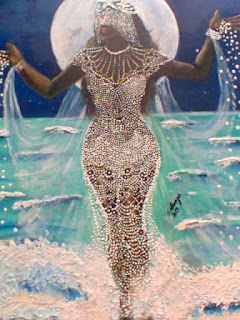Mother of the Feminine Priniciples
Yemoja is addressed as mother of over three hundred gods and goddesses in the Yoruba pantheon. She is the fountainhead of their existence. In the mother-cell begins all living things. She is the force of nature associated with the feminine creative principle and the subconscious. Ye-mo-ja originates from the name Yeye–Omo-Eja, mother of the fish. The word Omo is used in a generic sense and is associated with the Ogun River. I was to pay homage to the Yemoja priestesses while in Abeokuta, but they were closeted while I was there.
In primordial times, it is said that women were the only race and procreated on their own. Parthenogenesis was the primordial form of re-production for all life, while sexual generation (epigenesis) arose later because of inferior environmental and nutritive conditions resulting in diminished fertility. Parthenogenesis was the original and natural form of reproduction in which growth and development of embryos occurred without fertilization (virgin birth).
Normal unfertilized egg cells when penetrated by a single sperm form after meiosis are haploid, with half as many chromosomes as their mother's body cells. The sperm causes an implosion of light or energy in its center that is visible under a microscope or using infra-red photography. Parthenogenetic offspring usually have the diploid chromosome number and the potential to be superhuman. Children born in this manner are rumored to be the mythical great leader, healer, or visionary of old. It is said that Buddha and Jesus’s mothers conceived their son immaculately. One, when in a state of blissful meditation under a banyan tree and the other through divine manipulation. Another great example would be my favorite Yemoja tale.
Yemoja was a beautiful woman, but she was undecided about getting married because she had an imperfection and was afraid that her husband would make fun of her. One day on her way home from the market, feeling afflicted because she was thinking how sad it was to be alone without children and husband to come home to. Ogun happened to be on the same trail and heard Yemoja musing to herself and felt a strong urge to marry her, so he hugged her, then told her; fear not, I know I look fierce and everyone fears me, but I promise to protect you and never to harm you.
From their union, a son called Orungan was born. It is said that Orungan harbored evil thoughts and committed incest with his mother one day when his father was gone. Yemoja was horrified and escaped, but her lustful son chased her and she fell exhausted to the ground, Water started to pour from her body and as the water started to transform into a lake the following deities were emanated; Olosa (Goddess of the lake), Olokun (God of the ocean), Dada (God of the vegetables), Sango (God of the lighting), Ogun (God of the iron and war), Oya (Goddess of the Niger River), Osun (Goddess of the Osun River), Oba (Goddess of Oba), Oosaoko (God of the agriculture), Osoosi (God of hunt), Oke (God of the Mountains), Aje Saluga (God of richness), Sopanna (God of variola), Orun (Goddess of the sun), Osu (God of the moon).
With all this in mind, there are unverified tales of how the Yemoja priestess take chosen women from different tribes, when they reached the age of fertility, their first period and closet them away for fasting, instruction and purification. They are encouraged to dance for hours and hours in an attempt to enter a state of bliss, in order to conceive in the old way. Epigenesis might interfere with the conception of highly evolved beings. Parthenogenesis is simple, lovely, gentle, and super-natural. A woman must be very close to the laws of nature in order to conceive in this manner. Sometimes a candidate for conceiving and giving birth the “old way” will not show up for generations.
Iya Ọlọrun; iya ti gbogbo wa; queen ti awọn okun jin; aabo ti awọn obirin gba ọ laaye lati wa ni mọ. A pe lori ọ, Yemoja, iya wa, ikun ti ẹda; a beere pe ifẹ rẹ npa lori wa bi awọn igbi omi okun.










ReplyDeleteThe above article is really enjoyable, explains everything in detail, the article is very interesting and effective. Thank you and good luck for the future articles
https://blog.mindvalley.com/principle-definition/